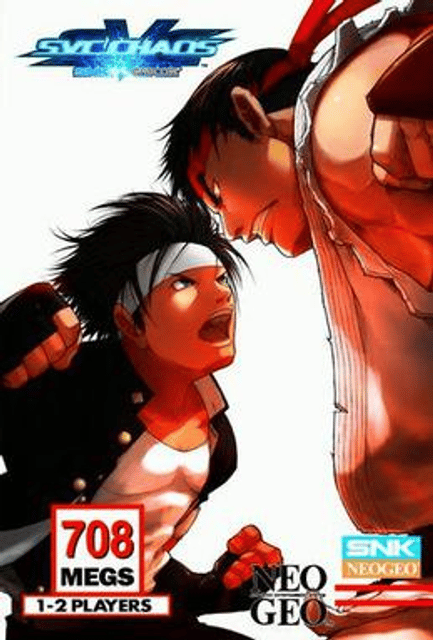SNK vs. Capcom: SVC Chaos

SNK vs. Capcom: SVC Chaos

| SNK vs. Capcom: SVC Chaos | ||
|---|---|---|
| Developer(s) | SNK Playmore | |
| Publisher(s) | SNK Playmore | |
| Producer(s) | Eikichi Kawasaki | |
| Artist(s) | Nona | |
| Composer(s) | Yasuo Yamate Masahiko Hataya Yasumasa Yamada | |
| Platform(s) | Arcade Neo Geo AES PlayStation 2 Xbox | |
| Release | ||
| Genre(s) | Fighting | |
| Mode(s) | Up to 2 players simultaneously | |
| Cabinet | Upright | |
| Arcade system | Neo Geo MV-0 | |
| Sound | Yamaha YM2610 | |
| Display | Raster, 304 x 224 pixels (Horizontal), 4096 colors | |
| Review scores | ||
| Publication | Score | |
| PS2 | Xbox | |
| 1UP.com | N/A | 30%[3] |
| EGM | N/A | 5/10[4] |
| Famitsu | 25/40[5] | N/A |
| Game Informer | N/A | 6.5/10[6] |
| GameSpot | N/A | 6.3/10[7] |
| GameSpy | N/A | |
| GamesTM | 60% | N/A |
| GameZone | N/A | 7.8/10[9] |
| IGN | N/A | 6/10[1] |
| OXM (US) | N/A | 7/10[10] |
| PALGN | N/A | 4/10[11] |
| Play | 67%[12] | N/A |
| TeamXbox | N/A | 6.5/10[13] |
| Aggregate score | ||
| Metacritic | 56/100[14] | 57/100[15] |
SNK vs. Capcom: SVC Chaos (エス・エヌ・ケイ バーサス カプコン エスブイシー カオス, Esu Enu Kei Bāsasu Kapukon Esbuishī Kaosu) is a 2003 fighting game produced by Playmore (now SNK) for the Neo Geo arcade and home platform. It was later ported to the PlayStation 2 and Xbox, although only the Xbox was released in North America[2], and both platforms were released in Japan and PAL.
The game is a crossover featuring characters from SNK's and Capcom's respective fighting game properties such as The King of Fighters, Samurai Shodown, Street Fighter, and Darkstalkers. It was the third arcade game in a series of crossovers between these two companies (see SNK vs. Capcom series) and the only one developed by SNK (SNK previously produced SNK vs. Capcom: The Match of the Millennium for the Neo Geo Pocket Color).
| SNK vs. Capcom: SVC Chaos | ||
|---|---|---|
| Developer(s) | SNK Playmore | |
| Publisher(s) | SNK Playmore | |
| Producer(s) | Eikichi Kawasaki | |
| Artist(s) | Nona | |
| Composer(s) | Yasuo Yamate Masahiko Hataya Yasumasa Yamada | |
| Platform(s) | Arcade Neo Geo AES PlayStation 2 Xbox | |
| Release | ||
| Genre(s) | Fighting | |
| Mode(s) | Up to 2 players simultaneously | |
| Cabinet | Upright | |
| Arcade system | Neo Geo MV-0 | |
| Sound | Yamaha YM2610 | |
| Display | Raster, 304 x 224 pixels (Horizontal), 4096 colors | |
| Review scores | ||
| Publication | Score | |
| PS2 | Xbox | |
| 1UP.com | N/A | 30%[3] |
| EGM | N/A | 5/10[4] |
| Famitsu | 25/40[5] | N/A |
| Game Informer | N/A | 6.5/10[6] |
| GameSpot | N/A | 6.3/10[7] |
| GameSpy | N/A | |
| GamesTM | 60% | N/A |
| GameZone | N/A | 7.8/10[9] |
| IGN | N/A | 6/10[1] |
| OXM (US) | N/A | 7/10[10] |
| PALGN | N/A | 4/10[11] |
| Play | 67%[12] | N/A |
| TeamXbox | N/A | 6.5/10[13] |
| Aggregate score | ||
| Metacritic | 56/100[14] | 57/100[15] |
Gameplay
The gameplay is based on the KOF series (particularly The King of Fighters 2002), with the same four button configuration and many of the same techniques. However, the game does not use the Team Battle format, but follows the traditional round-based one-on-one format. Each match begins with a dialogue exchange between the player's character and the opponent. One new technique introduced in the game is the Front Grand Step, which allows the player to cancel attacks with a forward dash. The player can perform this technique while guarding from an opponent's attack, which will consume one Power Gauge level.
The game uses a different type of Power Gauge known as the Groove Power Gauge System, which has three levels. The Groove gauge fills as the player lands attacks against the opponents or guard attacks. When the gauge fills to Lv. 1 or Lv. 2, the player can perform Super Special Moves, a Guard Cancel Attack or a Guard Cancel Front Step maneuver. When the gauge is full, its reaches MAXIMUM level and a MAX Activation occurs. During MAX Activation, the gauge will change into a timer and the player gains the ability to cancel any of their moves anytime (in addition to Super Special Moves and Guard Cancels). Once the timer runs out, the gauge returns to Lv. 2.
In addition to the regular Super Special Move, each character also has an 'Exceed' move which can only be performed once when the player's life is less than half.
Reception
| Reception | |||||||||||||||||||||||||||||||||||||||||||||||||||||
|---|---|---|---|---|---|---|---|---|---|---|---|---|---|---|---|---|---|---|---|---|---|---|---|---|---|---|---|---|---|---|---|---|---|---|---|---|---|---|---|---|---|---|---|---|---|---|---|---|---|---|---|---|---|
| |||||||||||||||||||||||||||||||||||||||||||||||||||||
The PlayStation 2 and Xbox versions received "mixed" reviews according to the review aggregation website Metacritic.[14][15] In Japan, Famitsu gave the PS2 version a score of three sixes and one seven for a total of 25 out of 40.[5]
In 2012, Complex ranked it as the 14th best SNK fighting game ever made, adding that "the game’s secret characters (Firebrand, Violent Ken, Zero etc.) had to be the best part about this game."[16]